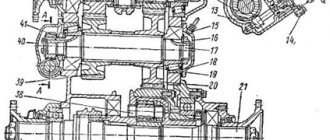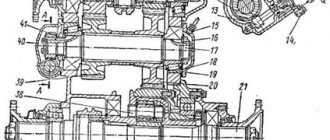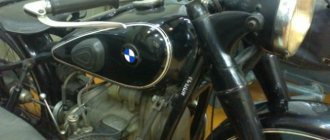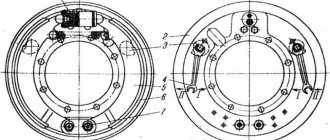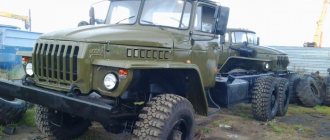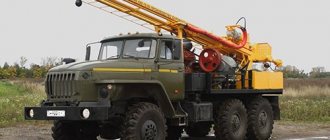Ural-4320 is an army military truck with all-wheel drive and a 6x6 wheel arrangement. Produced from 1977 to the present time. Over the years of production, the car has received many improvements. Today, the current model is one of the main trucks used periodically in the Armed Forces of the Russian Federation. The car received a large number of modifications, including a chassis with a traditional cab and a carrying capacity of 10 tons, as well as a long-wheelbase chassis with a loading capacity of up to 13 tons. In addition, there is a configuration with a reinforced front suspension and an option in the form of a pipe hauling tractor with increased load capacity. It should be noted that trucks for the Armed Forces of the Russian Federation are supplied exclusively in armored versions.
Qn = 0.01 x Hs x S x (1 + 0.01 x D) + Hot x T, (2)
where Qн is the URAL fuel consumption rate per 100 km, l; Hs is the transport norm of fuel consumption for the mileage of a URAL bus, l/100 km (taking into account the passenger load normalized by class and purpose of the bus); S —bus mileage, km; Hoth - fuel consumption rate when using standard independent heaters for the operation of the heater (heaters), l/h; T — operating time of the URAL bus with the heater on, h; D — correction factor (total relative increase or decrease) to the norm, %.
| URAL buses since 2008 | |||
| Model | Engine power, hp | Working volume, l | Fuel consumption rate, l/100 km |
| 1 | 2 | 3 | 4 |
Ural Next CNG-LNG and propane-powered KAMAZ: new cargo products from the Gas Forum in St. Petersburg
It was known in advance that at the Gas Forum in St. Petersburg it would be possible to see the Ural Next, the engine of which runs not only on compressed gas, but also on liquefied gas. But it appeared at the exhibition literally on the last day of its work: the Ural came here along with the trans-European run of gas vehicles “Blue Corridor”. After the ceremonial finish, I was able to get to know the new Ural better. I also noticed a KAMAZ, whose engine runs on propane. But first things first.
The gas Urals are powered by methane not only in compressed (CNG) but also in liquefied (LNG) form
The Ural Next presented at the exhibition can be called twice gas. He deserves this title for his original idea of combined nutrition. Its engine (converted YaMZ-536), as already mentioned, consumes methane in two forms at once - the usual compressed and liquefied. We described in detail the principle of operation of a liquefied gas (LNG) engine in the material about Iveco Stralis NP, and now the new technology has reached the domestic truck manufacturer.
The fuel type switch is located on the dashboard
Behind the cabin there is a box with nine compressed gas cylinders with a total volume of 892 liters, and on the frame on the left is a cryogenic tank (Chinese brand CIMC), which stores 450 liters of liquefied methane cooled to minus 162°C. The total reserve is enough for a thousand kilometers “with a tail” - the Urals checked this during the run.
I also managed to ride a little in the gas-powered Urals. And I noted that the engine is quieter than the diesel version, and there is an order of magnitude less vibration: the ignition is now spark-based. But the noise from the transmission became more audible, especially from the “toothy” off-road tires.
Now the family of “large” YaMZ-536 engines has also become completely gas
The designers' idea is that the range of the big-gas Urals is much higher: you can refuel with the type of gas that is available in the area. The downside is that more than a ton of weight is consumed by refilled cylinders and gas equipment. However, in the case when the machine is used as a technical vehicle, the loss of carrying capacity is not very important.
A new product for the forum was the propane KAMAZ-65116
Of the other gas vehicles, the greatest interest was attracted by the KAMAZ-65116 standing alone in the corner of the pavilion. Its peculiarity lies in the fuel used: it is not methane, but propane. The experienced tractor was assembled by one of the main gas players in the cargo market, RariTEK, whose plant we wrote about. This KAMAZ is equipped with a new, all-gas engine of the 820 family, developed in cooperation with the American company EControls.
The idea is great: there are a lot of propane gas stations in Russia, the technologies have been developed since Soviet times, the pressure in the cylinder is lower, and therefore their weight is less. By the way, there are three cylinders, 210 liters each, but for safety reasons the volume of propane is limited to 504 liters. But even with such a reserve, KAMAZ will be able to travel a thousand kilometers.
Why haven’t heavy propane-powered trucks been seen at similar exhibitions so far? The fact is that the state subsidy program does not apply to them. Accordingly, there are few people willing to purchase such equipment.
URAL
URAL 3255-0010-41 (shift 22 places; YaMZ-236-NE2)23011,1534,2DURAL 32552-0010-01 (shift 23 places; YaMZ-236 M2)18011,1528,9D| URAL trucks up to 2008 | ||
| Model | Fuel consumption rate, l/100 km | Type of fuel |
Cabin interior
I’ll start right away with the fact that carburetors below the K-68 series have a priori not low fuel consumption, this is confirmed by the carburetor manufacturer itself, and in practice it is also noticeable, the consumption of the K-68 is 10-15 lower, this is justified by its technological solutions in the form of an oval intake windows, a new round-shaped damper, a shorter needle, and some other little things. 04 D-243MMZ-4L-4.75-81-5M ZIL-431412 20.5 AP-17 GAZ-53A 32.0 3.5 APK-30 Ural-375 66.0 5.0 AT-53G GAZ-53A 27.5 3.5 VI-23 ZIL-130 35.0 4.0 VS-18 MS GAZ-52-03 27.5 3.0 VS-22 ZIL-508.
URAL
Ural-355, -355M, -355MS30,0BUral-375, -375AM, -375D -375DM, -375DU, -375K, -375N, -375T, -375YU50BUral-377, -377N44BUral-432032DUral-4320232D| URAL trucks since 2008 | ||||
| Model, brand, modification of the car | Engine power, hp | Working volume, l | checkpoint | Fuel consumption rate, l/100 km |
| 1 | 2 | 3 | 4 | 5 |
What are the consumption standards for truck cranes and what are they? Ural tourist
| Ural 5557 technical specifications, price and photos 90A GAZ-66 32.50 0.200 0.110 ASO-8 66 GAZ-66 33.50 0.180 0.110 ASO-672, AG-672 PAZ-672 36.00 0.200 0.110 ASO-20 3205 PAZ- 3205 36.00 0.200 0.110 ATCO-20 43101 KAMAZ-43101 36.00 0.200 0.150 AT-3 131 mod. In addition to domestic parts, it is based on many imported components such as DENSO, Sachs, which gives the bike excellent performance. |
| Onboard Ural-4320-0911-30 - URAL 4320 cars In order for the motorcycle engine to start well and quickly gain momentum, at least two systems should be ideally adjusted - the ignition system and the power supply system. 63B ZIL-431412 41.50 0.330 0.150 ATs 2.5-40 4333 PM-540 ZIL-4333 41.50 0.330 0.150 ATs 3.0-40 4 433104 ZIL-4331 33.00 0.250 0.110 ATs-3, 0-40 433104, ATs-40 433104 001-MM ZIL-4331 33.00 0.240 0.110 ATs 4-40 433104 mod. |
- This is the color of the candle when properly adjusted. As you can see, the brick color of the spark plug insulator is due to correctly tuned carburetors.
- If the candle is black, this is a sign of a rich mixture. Therefore, we lower the needles in the carburetors by one notch (initially they should be installed in the middle position).
- If the candle has white carbon deposits, raise the needles by one notch.
Chassis • 181 ZIL-133G1 54.50 0.330 0.150 ATs-40 375 Ts1 mod.
Qн = 0.01 x (Hsan x S + Hw x W) x (1 + 0.01 x D)
where Qн is the fuel consumption rate of the Ural dump truck, l; S — mileage of the Ural dump truck, km; Hsan is the fuel consumption rate for the mileage of a dump truck in running order without load;
| Ural dump trucks since 2008 | |||
| Model, brand, modification of the car | Engine power, l. With. | Working volume, l | Fuel consumption rate per 100 km |
| 1 | 2 | 3 | 4 |
| URAL-55571(YAMZ-236NE2) | 230 | 11,15 | 43.8D |
| URAL-63685-10 (YAMZ-760.10) | 300 | 11,15 | 43.0D |
Tourist, Tourist 2WD, Gear-UP, Troika Lux – Ural patrol
176 240 Maximum torque, N m kgf m 883 90 Engine displacement, l 14.86 Engine type diesel Number and arrangement of cylinders V8 Compliance with environmental requirements Euro 0 Suspension Front dependent on two longitudinal semi-elliptic springs, working in conjunction with double-acting hydraulic telescopic shock absorbers Rear dependent on two semi-elliptic springs and suspensions, working in conjunction with double-acting hydraulic telescopic shock absorbers Transmission Gearbox YaMZ-236U, mechanical. There are combined deaeration and recirculation systems, combined with a phlegmatization system; at the end of July 1893, an additional line of more stringent conditions for ignition is connected to recirculation.
Qн = 0.01 x (Hsan x S + Hw x W) x (1 + 0.01 x D)
where Qн is the standard fuel consumption of a URAL van, l; S —van mileage, km; Hsan - fuel consumption rate for the van's mileage in running order without cargo;
For URAL vans operating without taking into account the weight of the cargo being transported, the normalized value of fuel consumption is determined taking into account an increasing correction factor - up to 10% of the base standard.
| Model, brand, modification of the van | Fuel consumption rate per 100 km | Fuel |
| 1 | 2 | 3 |
| Ural-326031 (YaMZ-236NE2-6V-11.15-230-5M) | 29,9 | D |
| Ural-4320-0111-41 (armored) (YaMZ-236NE2-6V-11.15-230-5M) | 33,3 | D |
| Ural-49472 | 53 | B |
The URAL fuel consumption rates are necessary for the work of the ATP and organizations related to the vehicle management and control system, individual entrepreneurs (IE) using automotive equipment and special rolling stock on the chassis of URAL buses, calculating the standard value of the URAL fuel consumption rates at the place of consumption, for maintaining statistical and economic reporting.
Description of design
The basis of the all-terrain vehicle is a frame made up of two spars stamped from steel, cross members and a front buffer. The spars have a variable cross-section along their length, ensuring uniform strength and rigidity of the structure.
The connection of the frame elements is made using rivets. The last cross member is equipped with a towing device. A fuel tank is installed on the frame. Its filling volume is 300 liters.
The front axle is mounted on longitudinal springs, supplemented by hydraulic shock absorbers. Rubber suspension travel stops are installed on the axle shafts and frame. The front end of the spring is mounted on a bracket through a pin, the rear end is movably mounted in an eye.
One of the sheets has a restrictive bend that prevents the spring from falling out of the bracket. The rear suspension is balanced, the spring moves freely in lugs installed on the axles.
Engines
The Ural-4320 all-terrain vehicles used several types of diesel engines. The engine type is reflected in the modification index added to the model. The “clean” version 4320 is equipped with a naturally-aspirated diesel engine of the KamAZ-740 type.
The engine has a V-shaped arrangement of eight cylinders and develops a power of 210 hp.
The Ural-4320-31 version is distinguished by the use of the YaMZ-238M2 8-cylinder power unit. The engine is built in a V-shape and develops a power of 240 hp. and complies with Euro-0 standards. A similar diesel engine is installed on modifications 4320-30. The technical characteristics of the Ural-4320-31 do not differ from the basic version.
The Ural-4320-10 modification is equipped with a 180-horsepower YaMZ-236M2 diesel engine. The six-cylinder engine has a V-shaped layout and an atmospheric air supply system. The first production of vehicles with a YaMZ-236 engine had an engine compartment similar to that of all-terrain vehicles with a KamAZ-740 engine. Since the mid-2000s, an extended compartment began to be used, which became standard for all variants of the Ural-4320 all-terrain vehicles.
Versions 4320-41 and 4320-40 received a diesel engine of a similar design, but equipped with a turbocharger and compressed air intercooler. Due to the turbine, power increased to 230 hp. Another difference is compliance with Euro-2 emissions standards (versus Euro-0 for a naturally-aspirated engine). Fuel consumption on the Ural-4320 with turbodiesel power plants is slightly lower.
Transmission
All-terrain vehicles with a KamAZ diesel engine were equipped with a 5-speed YaMZ-141 gearbox and a dry-type double-disc clutch. The Ural-43206 vehicle is equipped with a 5-speed YaMZ-236U gearbox. The clutch drives on all gearbox options are equipped with a pneumatic booster.
In addition to the main gearboxes, all Ural-4320 all-terrain vehicles use a two-speed transfer case.
The torque from the box is transmitted to the gearbox using a short driveshaft. The box includes a center differential equipped with a locking mechanism. The differential has an asymmetric torque distribution scheme.
The gearbox and transfer gear are controlled mechanically from the driver's seat using levers and a rod system. A power take-off box is installed on the transfer gearbox, which is used to drive a self-pulling winch installed under the cargo platform at the rear of the all-terrain vehicle. The winch is driven by three cardan shafts.
The bridges are equipped with a unified main pair, with double torque conversion. The first stage of the gearbox consists of bevel gears with a spiral tooth shape. The second stage includes two spur gears. Uraz-4320 all-terrain vehicles can be equipped with gearboxes with a gear ratio of 6.7...8.9 (a total of four gear ratio options).
Behind the main pair there is a bevel-type differential that controls the rotation of the axle shafts.
The axles have a through design; the middle axle is used to drive the rear axle gearbox. The front axle axle shafts are equipped with steering knuckles equipped with constant velocity joints.
Steering and electrical system
The steering of the Ural-4320 vehicle is equipped with a hydraulic booster operating in two directions. The steering column is connected to the gearbox via a cardan shaft. The column is not adjustable. The Ural-4320 all-terrain vehicles use an electrical system with an operating voltage of 24V. The negative terminals are connected to the car body.
Brake system
The brakes have a combined hydropneumatic drive. The hydraulics have two separate branches. The first controls the brakes of the front and middle axles, the second controls the brakes of the rear axle wheels. A tap is installed on the rear cross member of the frame for connecting the pneumatic brakes of the trailer.
The parking brake of the Ural-4320 vehicle is installed on the output shaft of the transfer gearbox. The brake is connected to the trailer brake valve by a mechanical rod. To improve braking performance, an engine compression brake is installed, which cuts off the fuel supply to the injectors.
Drum-type brake mechanisms are equipped with a system for automatically adjusting the gap between the linings and the friction surface of the drum. The mechanisms are located directly at the wheels of the all-terrain vehicle.
Body and other equipment
The Ural-4320 all-terrain vehicle is equipped with a completely metal cabin equipped with hinged doors. The cabin has an adjustable driver's seat and a rigidly fixed two-seater seat for passengers.
The salon is equipped with a ventilation and air heating system.
At the rear of the cabin there is a metal cargo platform equipped with a removable awning. To install the awning, arcs are used, which are installed in guide grooves on the side boards. The platform is equipped with two folding benches along the sides and an additional removable bench installed in the center.
The benches can accommodate 27 people. The Ural-4320 truck platform has a load capacity of 5000 kg when operating an all-terrain vehicle on roads with any surface. The overall dimensions of the platform have not changed compared to the Ural-375D.
Bitumen trucks
The basic model of the all-terrain vehicle from the Miass Automobile Plant received positive feedback from customers immediately after the first models rolled off the assembly line. This ensured popularity and widespread use in the civilian and military spheres. It is interesting that the plant itself produces exclusively the chassis, and all subsequent equipment for the truck is taken over by third-party companies. Today, the car plant produces several types of chassis, which can be equipped with both a standard suspension and options with reinforced springs installed on the front axle of the all-terrain vehicle. In the latter case, the truck is marked URAL-43203.
Technical Briefs Product Features
| Ural-4320 - Russian truck, history of development and use, design and characteristics, advantages and disadvantages, military and civilian modifications. They tell how, for example, representatives of this family proved themselves in the rescue operation of the Mexican army Ural-4320 in its arsenal in the American state Louisiana. Engineers of the Ural Automobile Plant began independently developing such an engine, but in the end, at the level of industry management, it was decided to transfer this process to the Yaroslavl Motor Plant YaMZ. |
| Technical characteristics of the Ural 4320, dimensions, engine power When driving without a trailer along the route simulating urban traffic, everything is very good, five gears in the box are enough for normal acceleration, the car is quite playful for its weight. Ural-4320-09-31 with a cabin, all the main elements of which are made of armored sheets, with the use of armored glass, internal locking, embrasures and a hatch for firing, the possibility of placing special equipment in the cabin and an armored module for 15-20 soldiers under an awning in body;. |
History of creation • Ural 4320 is an all-wheel drive three-axle truck with a 6x6 wheel arrangement.
Modifications
There are a considerable number of Ural-4320 off-road trucks, and each of them has its own feature:
- Ural-4320-01 - was produced in 1986. It is dominated by an improved version of the cabin, unlike the previous version, a different platform and gearbox. Went along with the Kamazov engine;
- Ural-4320-10 - produced with a 6-cylinder power unit YaMZ-236, which produces 180 horsepower. The vehicle was designed for transporting various cargoes, people and towing trailers on and off-road. The installed winch always helped out when getting stuck (which happened very rarely), it could be designed for a distance of up to 65 m;
- Ural-4320-31 - released in 1993 with an 8-cylinder power unit, the power of which increased to 240 horses. Moreover, it comes with improved power density settings;
- Ural-4320-30 - a truck with an increased wheelbase and increased load capacity;
- Ural-4320-41 is a truck with a Yaroslavl plant engine (YaMZ-236NE2), produced in 2002. It met Euro-2 standards and had 230 horsepower;
- Ural-4320-40 – modification 4320-41, only with an extended base;
- Ural-4320-44 - produced in 2009 - the same version 4320-41, only differing in the cabin, which has increased comfort;
- Ural-4320-45 – Ural-4320-44 truck, with an extended wheelbase;
- Ural-4320-48 - comes with the YaMZ-7601 power unit. This version of the machines was specially produced for the installation of special equipment.
It turns out that in different versions of the Ural-4320, the engine power was radically different. There was a particularly significant appearance in 2009 of a new version of the truck, where the cabin was equipped with additional comfort. For example, the hood was made of fiberglass. Moreover, a stylish unique plumage appeared. Starting this year, the auto company is worried not only about the off-road properties of the truck, but also about the convenience of staying in the driver’s cabin, which has not received so much attention before.
It is worth saying that when assembling the truck, the engineers thought about the person who would drive the Russian car. The steering wheel was not without a hydraulic booster. The cabin had a pretty good heater. The driver's seat is adjustable in three directions - height, length and adjustable backrest tilt. There are headrests and armrests, making the ride more comfortable. We started installing seat belts.
The interior began to be made from materials that provide good noise and heat insulation. The instrument panel has a convenient location. All sensors and meters are easy to read, and the necessary buttons and switches can be used without leaving the driver’s seat. There is also a rather large and rational glove compartment, and a shelf for storing papers and other things and property. Under the passenger seats there is a tool chest. It is possible to equip the car with a sleeping place.
Weaknesses of the IMZ-8.103-10 (IMZ-8.103-30, M-67-36) engine of the Ural motorcycle
79A UAZ-3741 18.00 - 0.060 ASh-5 22034 RAF-22034 16.50 - 0.060 ASh-5 39620 UAZ-3962, 37411 19.00 - 0.060 ASh-6 3205 PAZ-3205 36.00 - 0.11 0 ALP-5 3962 UAZ-3962 19.00 — 0.060 ALP-6 452 mod. K-38 K-301G K-301B K-301G K-302 Type of air cleaner Combined inertial contact-oil filter with two-stage cleaning Characteristics of transmissions of motorcycle modifications Ural M62 M63 M66 M67 M67-36 IMZ-8-103 Clutch type Dry 2-disc , driven discs with linings on both sides Cardan transmission type With cardan shaft and elastic coupling and hinge on needle bearings Main gear type With 2 bevel wheels with spiral teeth, gear ratio -4.62 Gearbox type 4-speed, has gear ratios in I, II, III, IV gears of 3.6; 2.28; 1.7; 1.3 respectively Filling volumes of gasoline and oils of modifications of Ural motorcycles, in liters M62 M63 M66 M67 M67-36 IMZ-8-103 In the fuel tank, gasoline A-80 20 19 In the engine crankcase 2 2.3 In the gearbox crankcase 0.8 1.2 In the final drive housing 0.15 0.13 0.11 In the air cleaner 0.2 0.125.
Diesel Ural-4320 • Development history
The military generally respects diesel more, but there is also a relatively small resource, and gasoline, and an enormous appetite. It was necessary to do something with this machine, and first of all, change the power unit. 18 6L-11,1-392-18M 18,6 D Scania P114 GA 6×4 NZ340 Griffi 6L-10,64-340-9M 18,7 D Scania R 113 MA 400 6L-11,021-401-14M 16,0 D Scania R 124 LA 400 6L-11.7-400-12M 16.0 D Scania R 420 LA 6L-11.705-420-14M 17.7 D Scoda-LIAS-100.
| Options | Values for standard model | Range of values for modifications |
| Length | 7588 mm | 7388-9545 mm |
| Width | 2500 mm | 2500 mm |
| Height | 2785 mm | 2670-3095 mm |
| Wheelbase | 3525 + 1400 mm | 3525-4555 (+1400) mm |
| Ground clearance | 400 mm | 360-400 mm |
| Curb weight | 8.265 t | 8.0-8.7 t |
| Maximum weight | 15.2 t | 12.2-20.7 t |
Brakes • Development history
| Order of the Ministry of Transport of the Russian Federation dated March 14, 2008 No. AM-23-r Appendix Fuel consumption standards for special and specialized vehicles This powerful off-road truck can be operated in the most severe conditions, invariably surprising others with its reliability and brutal appearance. The main drawback of all the first modifications of this car was the extremely voracious gasoline engine, which consumed about 50 liters of expensive high-octane A-93 gasoline per 100 kilometers. |
- Ural-43202 - wooden platform with high sides;
- Ural-43203 - version for installation of various types of vans and KUNGs;
- Ural-43204 - timber (pipe) version, designed to work with a trailer;
- Ural-43206 is a two-axle version with a 4x4 wheel arrangement.
How to calculate fuel consumption for Kamaz?
General calculation formula:
- Qh=0.01*Hsanc*S*(1+0.01*D)+Hz*Z.
- Hsanc=Hs+Hw*(Gpr+0.5*q)
- Qh=0.01*(Hsan*S+Hw*W)*(1+0.01*D)
Interesting materials:
How to remove keratin from hair? How to remove a site from suggestions? How to remove sugar from dough? How to remove sugar from jam? How to remove self-diagnosis in Hamachi? How to remove Samsung account? How to remove the FPS counter in CS GO in the upper corner? How to remove gray tint from hair? How to remove the gray background of text in Word 2010? How to remove a ballpoint pen from a soft toy?


